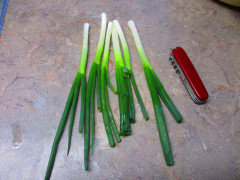2024 February week 1
AmyinOwasso/zone 6b
2 months ago
Featured Answer
Sort by:Oldest
Comments (92)
Related Discussions
February 2021 Week 1
Comments (61)I am a little nervous about the forecast. I've never cared for so many animals in weather like this, that lasts for so long. Tom did a DIY chicken waterer warmer today. Hopefully that will work well. We pulled the torn frost cloth off the hinged hoop and added plastic today. Lettuce is in that bed. I covered the other beds with frost cloth while Rick worked on the hoop house door yesterday. I am considering placing plastic over the artichoke. Artichoke is a surprise for me. I thought it thrived in the heat, but it seems to prefer wet and cool. The dogs will be miserable stuck inside. And I'm sad for my neighbors' pets that live outdoors. Rick bought a couple of 50lb bags of potatoes (one is a red and the other a white potato, I think) at Ellison's, Rebecca, but Norman is a little far for you to drive. I'm not sure what their mask policy is. Will probably start more broccoli tomorrow, as well as some flowers....and a few tomatoes for Dawn. I haven't decided yet which tomatoes to start. It will just be a 4 or 5 cups. Kim, I would take some fig cuttings if you're sharing at the Fling. Out of the 36 cabbage and 36 broccoli pellets, about 24 each look good. Lowes has broccoli and other plants out. My leek order is placed. I ordered more black bean seeds because we only have 5 jars left. Need to focus more on the beans this year and less focus on the peas. SESE was out of black beans. Vermont has the small packages, but not the large ones available. A woman at Walmart breezed by me today. Her cart was completely loaded with canning supplies including jars. I mean, overflowing with supplies. Also, food saver things. She must have grabbed all the lids because both the regular and wide mouth were gone. I wish I didn't feel so unsettled about the weather....See MoreHealthy Lifestyle Progress - Week of 1/28/2024
Comments (16)Sorry for everyone who is dealing with illnesses. It is so difficult to keep on track when stuff comes up. Gscience you have my admiration for focusing on your exercises. For many years with my physical struggles I used my health problems as an excuse. No more. As far as I'm concerned never again. But I really do believe we all have to decide for ourselves whether we are going to struggle with this or use our energy for something else. I hope this procedure you have done was helpful and took care of the problem. Hugs to you. Hugs to everyone. For me it's the cold I had for two and a half weeks. It has finally loosened it's hold on me. Also the stupid migraines. B2 vitamins seem to be taking the edge off so hopefully they will work as well as the flax oil did that took my migraines away completely for those 5 years. Exercise is going well. I am generally sticking to it. I do the exercises three times a week but I also don't do it exactly on the same day some weeks. Yesterday I was playing catch up for Wednesday's exercise day. I will likely fudge it and do it later tonight for my Friday so I don't have to do those kind of exercises on Saturday and Sunday. I truly love my weekends off. So in general with the exercises intermittent fasting and trying to get a handle on my health things are working. I have to watch my cheese intake darn it. I love cheese. It settles nicely on my hips.. Best to everyone! Have a great weekend! I do think of you often; I'm just not a very good writer.. still know that I'm here sometimes way too silently supporting you all....See MoreWhat are you reading? February 2024 Edition
Comments (60)Just finished The Winter Soldier. I liked it very much, 4 stars. Thanks to those who mentioned it in the January thread. You guys have the best recommendations. I was hoping for a different ending, but it was a just ending. It's the first Daniel Mason book I've read and love his writing. Straightforward but evocative. I have North Woods on hold. Turns out Mason is my daughter's age and is from Palo Alto....See MoreVeggie Tales >>> February 2024
Comments (23)A nice day yesterday to get some gardening going without being too cold or too warm, perfect, no sweat. I prepped the rows for the cabbages, broccoli, carrots, beets, and lettuces. Will start on the pea plot today and begin planting all of these veggies (seeds & transplants) in about 2 weeks or so. Keeping an eye on the long range forecast for any cold snaps but so far any predicted nite temps below freezing are few. Soil moisture is excellent for a very good start and the earthworms were very abundant. Some daffodils are budding up now but thankfully the fruit trees are still dormant except for the early plums being near bud swell, I expect the other trees will wake up next when temps warm up to around 70F this week, but a cool snap after that down into the 30's is expected. I'll get going on prepping the summer crop plots sometime in April....See MoreAmyinOwasso/zone 6b
2 months agoAmyinOwasso/zone 6b
2 months agoAmyinOwasso/zone 6b
2 months agoAmyinOwasso/zone 6b
2 months agoAmyinOwasso/zone 6b
2 months agolast modified: 2 months ago
Related Stories

EVENTS2016 Palm Springs Modernism Week Tickets Go on Sale
November 1 is the first day to buy tickets to the February festival celebrating 20th-century architecture and design
Full Story
LATEST NEWS FOR PROFESSIONALS10 Design Trends for New Kitchen and Bath Products in 2024
See the latest shower features, countertop looks, faucets, appliances and more that debuted at the KBIS 2024 trade show
Full Story
EVENTS10 Design Trends for New Kitchen and Bath Products in 2024
See the latest shower features, countertop looks, faucets, appliances and more that debuted at the KBIS 2024 trade show
Full Story
MONTHLY HOME CHECKLISTSTo-Dos: Your February Home Checklist
Keep your home fresh and organized this month while you plan for warmer days ahead
Full Story
EVENTSModernism Week 2015 Opens in Palm Springs
The city’s 10th annual festival celebrates midcentury architecture and design. Here’s a look at what’s on view
Full Story
KITCHEN DESIGNNew This Week: How Dark Can Your Kitchen Go?
These 3 kitchens wow with dark cabinetry and drama
Full Story















slowpoke_gardener